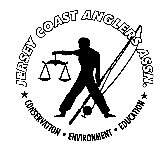 JCAA Newsletter JCAA Newsletter
|
|
February 2008
|
|
NOTICES
|
|
JCAA High Roller Raffle
|
|
It is now time for the JCAA High Rollers 2008 Raffle. We have put together a terrific selection of rods and reels and other prizes for a raffle that will be drawn on April 29, 2008. This is a major fundraiser for the JCAA. The 8 prizes are listed below with a value of almost $3,500. Tickets will be two.....
|
Read full article
|
|
JCAA Needs Volunteers to Help Man the JCAA booth Atlantic City Boat Show
|
|
Atlantic City Boat Show February 6th–10th. See the show while you work the booth. This a five day show and we need your help. If you can help, contact Mark Taylor at 732-929-2591. You can also email him at mtsport64@aol.com.
|
|
|
|
|
President's Report
by John Toth
|
|
Pot Bill - We had great hopes that this bill would pass since the Senate passed it unanimously during the closing session of the Legislature. It passed by 33 votes to 0 votes in opposition. All we had to do was to get Assembly Speaker Roberts to post it in the Assembly and it would most......
|
Read full article
|
|
|
Fisheries Management & Legislative Report
by Tom Fote
|
|
Update on Summer Flounder Research
|
|
Last month I discussed the $15,000 JCAA has earmarked for summer flounder research. The coalition is the Partnership for Mid-Atlantic Fisheries Science Inc. (PFMAFS). This group will hire scientists to be part of the 2008 benchmark summer flounder stock assessment. To date the groups that.....
|
Read full article
|
|
ASMFC Commission
|
|
The agenda for the ASMFC meeting is below. I will be attending the meetings. The schedule makes it difficult for the public to attend these meetings. I understand there are reasons the ASMFC commissioners decided to break up the schedule. For instance, striped bass is on.....
|
Read full article
|
|
JCAA’S Participation in the Marine Fish Conservation Network
|
|
There has been much public discussion about why JCAA belongs to the Marine Fish Conservation Network. In 1994 when the Marine Fish Conservation Network was first formed, JCAA was invited to participate along with many other recreational organizations. JCAA decided to.....
|
Read full article
|
|
Pots Off the Reefs Legislation
|
|
I know many of you were as disappointed as I was that the NJ Assembly never voted on the Pots Off the Reefs legislation. There have been many articles published about this failure. The two articles below by Al Ristori will give you a good picture of what happened and what you.....
|
Read full article
|
Artificial Reef Bill Headed to Assembly
By Al Ristori, Star Ledger 1/18/08
|
|
Anglers and divers are gearing up for another attempt to protect the state's artificial reefs for the purpose they were intended -- hook and line fishing. Energized by the 33-0 passage in the Senate during the last session, anglers hope for a better outcome this time in the.....
|
Read full article
|
Pots on Reefs Still a Problem
By Al Ristori, Star Ledger 1/13/08
|
|
The refusal by Speaker Joseph Roberts Jr. (D-Camden) to post the bill that would have ended potting on the state's artificial reefs on the last voting day of the old Assembly pretty much ended hopes of protecting them for public use before supporters have to start the process from scratch.....
|
Read full article
|
|
NJ Environmental Federation Conference
|
|
New Jersey Environmental Federation’s 22nd Annual Conference will be held on Saturday April 5, 2008. There will be many workshops focusing on global warming. I will be moderating a panel discussion on the impact of drugs and other endocrine disruptors that are increasingly.....
|
Read full article
|
Fluke Season Lasts One Day in New Jersey
By Kirk Moore, Gannett News Service 1/6/08
|
|
Shoppers will find lots of fresh New Jersey fluke in their local fish cases this week. But it won't last for long. Fishermen who put their nets out just after midnight early this morning will get just one day's haul of 7,500 pounds out of the January commercial season for summer flounder, or.....
|
Read full article
|
Regulators Make Fluke Anglers Very Anxious
By John Geiser, Correspondent
|
|
Every day that is crossed off the calendar from now on leaves fluke anglers increasingly worried about what the regulators will allow them to fish for this year. John Toth, president of the Jersey Coast Anglers Association, got some attention on the problems of the fluke fishery when he.....
|
Read full article
|
|
|
Highly Migratory Species Report
by John T. Koegler
|
|
An Important Meeting on Fishery Issues |
|
The National Association of Charterboat Operators (NACO) annual meeting was held at Chesapeake Beach, MD. on January 15. They had 6 quality speakers who provided key information about a wide variety of key fishery issues. The first speaker was Dr. John Boreman who gave......
|
Read full article
|
|
National Recreational Angler Registry |
|
Gordon Colvin, New York State, now heads NMFS National Recreational Angler Registry division. This program will create a current list of angler names and phone numbers so that the MRIP callers will reach fishermen rather than random coastal residents. They expect to greatly improve.....
|
Read full article
|
|
Transportation Workers Identification Card - TWIC |
|
This is the latest gem from Homeland Security’s TSA. All workers in commercial docks/yards or who work on ships, plus all those who hold a USCG license, are mandated to obtain this new card. They are required to obtain this card by Sept. 25, 2008. The cost is $135.00 for 5 years. Visa.....
|
Read full article
|
|
Important Note |
|
Charter and head boat captains MUST POSSESS one of these new TWIC cards to renew their current captain’s license. Their USCG license will not be renewed without a TWIC. USCG estimates 800,000 licenses will be issued. Only 50,000 had been issued as of December 31. It will get real.....
|
Read full article
|
|
USCG - DUI Facts for Charter and Head Boats |
|
DUI packets that determine if you had consumed alcohol have been required by the USCG for the last two years for all captains and crew. Captains were directed to use them immediately if they had a reportable incident on a for-hire boat. It was noted by the speaker that these.....
|
Read full article
|
|
ICCAT Report |
|
The Bluefin Tuna fish is in real trouble. All European and African nations who are members of ICCAT have refused for the last 31 years to pass national regulations that would control and regulate the out of control Mediterranean and Eastern Atlantic bluefin fishery. Rich Ruais is a.....
|
Read full article
|
|
ICCAT Yellowfin and Longfin Tuna Report |
|
Those who enjoy canyon fishing over the last 20 years have found their former superb fishing reduced to a hit or miss opportunity and now land only a few tuna per trip. Yellowfin and Longfin tuna are the species usually caught on 95 % of the canyon trips. ICCAT voted to reduce their....
|
Read full article
|
|
Swordfish Stocks |
|
As you remember, the US swordfish biomass has recovered to the point where their numbers are estimated to support MSY landings. The September/October issue of Sport Fishing has a superb article on daytime swordfishing in 1,500 feet using braided line. See pages 70-77. Having.....
|
Read full article
|
|
|
Youth Education Report
by Greg Kucharewski
|
Get Ready for Spring
The cold winter months are here and its time to get our fishing equipment ready for the spring thaw. I like to prepare my fishing equipment and terminal tackle according to the specious of fish I fish for early in the spring starting with the following: Winter Flounder rigs, black fish.....
|
Read full article
|
|



